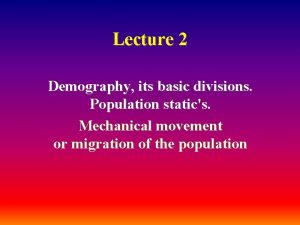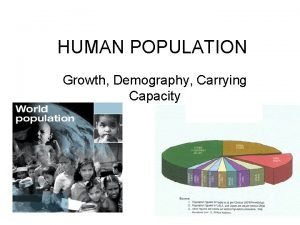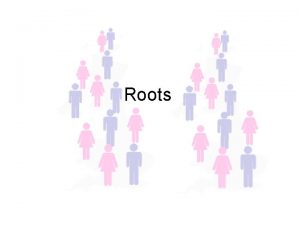DEMOGRAPHY World Population Growth POPULATION GROWTH Three factors







- Slides: 7

DEMOGRAPHY World Population Growth

POPULATION GROWTH Three factors determine population growth: birthrate, death rate, and net migration. Net migration is country-specific and is equal to immigration minus emigration. The histories of culture, conflict, and politics of each country are unique, as are each country's economy and resources. All of these factors affect a country's human population growth today.

STUDYING POPULATION GROWTH You have been asked to develop a briefing on population growth using example countries that exhibit high, moderate, and low population growth. You will develop profiles that reference recent histories of birthrate and death rates, as well as present age structure. You will use these data to determine which stage of the demographic transition each country is in.

DEMOGRAPHIC TRANSITION The demographic transition in a country occurs in three stages. Stage 1: Initially death rates decline as a result of improved health care and sanitation; birthrates remain high. Stage 2: Birthrates begin to decline as a country improves employment, wages, and education. Stage 3: Birthrates and death rates are similar to each other and population growth is low, stable, or negative. Review demographic data from various countries and compare the patterns to assess the stage of demographic transition that each country is most likely to be experiencing.

HIGH AND LOW BIRTHRATES High Birthrate Developing countries tend to have higher birthrates. Statistically, mothers bear their first child at a younger age and, on average, women bear more children. Low Birthrate tends to be lower in developed countries. On average, women bear children later in life and bear fewer children.

PRACTICE Record the values of relevant variables to assist you in your assessment of the countries’ demographies. When you have completed the table write your conclusions about the data. Birth Rate Death (per 1000) Rate (per 1000) Angola Kenya Canada Denmark Mother’s Maternal Immigratio Growth age at first Death Rate n rate (per Rate (per birth (per 1000) year) 100, 000) Median age (years) Life Expectan cy (years)

CONCLUSIONS 1. Describe your assessment on each country´s position in the demographic transition and explain your conclusions. 2. What is your assessment of each country´s future growth expectations. Explain.













